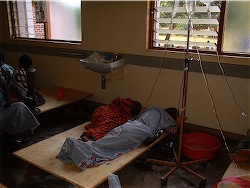"Cholera is an acute illness that can bring death if not treated quickly. It is caused by an infection of the intestine with the bacterium Vibrato cholera. Although the infection can be mild and without serious symptoms, it can also be extremely serious and severe. Approximately one in 20 infected persons have a severe case of cholera. In this case the illness is characterized by extreme watery diarrhea, vomiting, and leg cramps. In these persons, a rapid loss of body fluids can lead to dehydration and shock. Without treatment, death can occur within hours."
How can I get cholera?
"A person can come down with cholera from drinking water or eating food that is contaminated with the cholera bacterium. When an epidemic occurs the source of the contamination is usually feces from an infected person. The
.jpg) disease often spreads rapidly in areas where there is inadequate treatment of sewage and drinking water. Cholera is not likely to spread directly from one person to another and thus, casual contact with an infected person is not a risk for becoming ill."
disease often spreads rapidly in areas where there is inadequate treatment of sewage and drinking water. Cholera is not likely to spread directly from one person to another and thus, casual contact with an infected person is not a risk for becoming ill."Can I get cholera in the U.S. or Europe?
"In the United States cholera was prevalent in the 1800s but has been virtually eliminated by modern sewage and water treatment systems. The same is true of most other developed nations of the world. The problem remains a serious threat to life in the underdeveloped nations of the world, including most of Africa. The problem usually strikes Malawi each year during the rainy season when raw sewage is more prevalent because of the lack of adequate sewage treatment."
Shipment arrives just in time
"Thanks to the cooperation of the Malawi Project and World Emergency Relief, a shipment of approximately $4 million in medicines arrived in Malawi. A large portion of the shipment contained ORS, a critical item needed in order to stem the consequences of a serious outbreak of cholera. Medical facilities all over Malawi were without any ORS. The Dzidalire Group, a humanitarian group headquartered in Lilongwe distributed the shipment to many of the affected areas on the nation."
What am I looking at in the pictures?
"The two pictures accompanying this article were taken during an earlier cholera epidemic in Malawi. With the seriousness of the diarrhea pieces of plywood have holes cut in them at the appropiate places and laid on bricks. Pans are place under the plywood and the patients are laid out all over the room."

